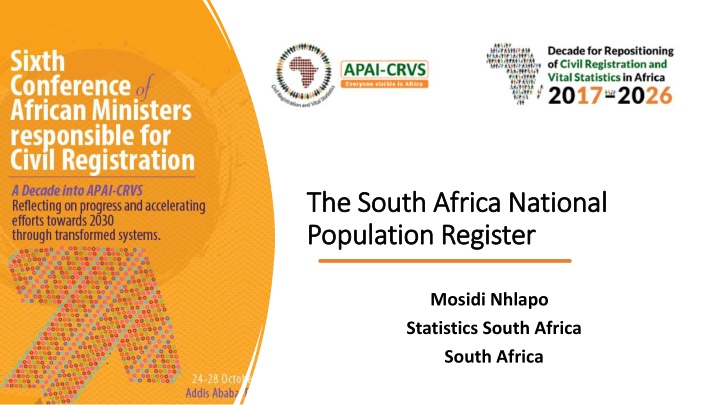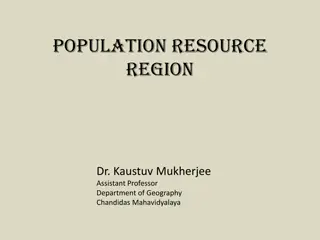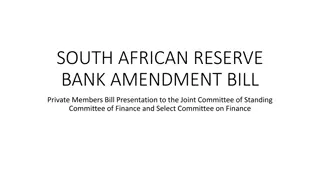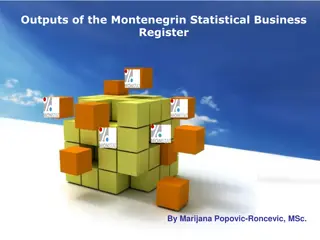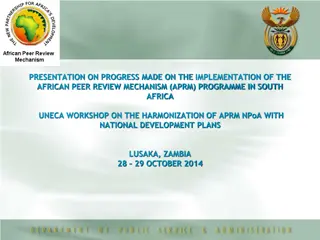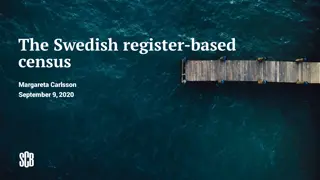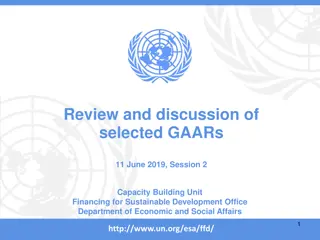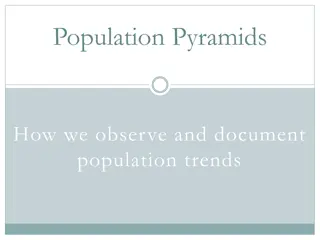Overview of the South African National Population Register
The South African National Population Register (NPR) is a vital system maintained by the Department of Home Affairs. It serves to record and update information on the country's resident population, issue identity documents, and handle related administrative tasks. The NPR has evolved over the years through legislation, including the Population Registration Act of 1950 and subsequent amendments. Operational since 1972, the register encompasses various population groups and undergoes regular updates to reflect life events like births, marriages, and deaths.
Download Presentation

Please find below an Image/Link to download the presentation.
The content on the website is provided AS IS for your information and personal use only. It may not be sold, licensed, or shared on other websites without obtaining consent from the author.If you encounter any issues during the download, it is possible that the publisher has removed the file from their server.
You are allowed to download the files provided on this website for personal or commercial use, subject to the condition that they are used lawfully. All files are the property of their respective owners.
The content on the website is provided AS IS for your information and personal use only. It may not be sold, licensed, or shared on other websites without obtaining consent from the author.
E N D
Presentation Transcript
The South Africa National The South Africa National Population Register Population Register Mosidi Nhlapo Statistics South Africa South Africa
Outline C Context on population registers H Historical development P Purpose L Legal Instruments S South African NPR as a live system W Who is in the NPR H How has NPR been used C Challenges
Population Registers N National Population Registers (NPR) - mechanisms for continuous recording of selected information pertaining to each member of the resident population of a country; O Organisation and operations should have a legal basis; P Population registers start with a base consisting of an inventory of the inhabitants of a country and their characteristics; T To assist in locating a record for a particular person, household or family in a population register, an identification number is provided for each entity.
South African Population Register South African Population Register- - Legislative arrangement Legislative arrangement F First implemented through the Population Registration Act of 1950. I Identification Act, 1986 (Act No. 72 of 1986) inclusion of Black Africans. P Population Registration Act Repeal Act, (Act No. 114 of 1991) - abolished the distinction between population groups. S South African Citizenship Act (Act No. 88 of 1995) I Identification Act (Act No. 68 of 1997).
Historical development O Operationalised in 1972 for the white, coloured & Indian population groups B Black Africans only included in the NPR from 1986, T Theregister is a product of the civil registration system; it is updated every time a person s status changes through birth, marriage, alteration of sex status, or through death.
P Purpose development T The heSouth African National Population Register (NPR) is a register of the population of South Africa, held by the Department of Home Affairs (DHA). T The purpose is: To provide for the compilation and maintenance of a population register in respect of the population of the Republic; for the issue of identity cards and certain certificates to persons whose particulars are included in the population register; and for matters connected therewith
NPR NPR - - register of registers register of registers National Population Register Deaths register (Stillbirths) Divorce Register Births Register Marriage Immigration
SA NPR as a live system 16 Issue ID document 0+ Links mother & child/children Births Issue Passport NPR database Naturalisation Marriage register Entry into the NPR Death 60 Recognition Triggers pension payment Divorce
South African NPR South African NPR Inclusions All children born of South African citizens and permanent l children born of South African citizens and permanent residents when the notice of the birth is given. residents when the notice of the birth is given. Upon attainment of the age of 16, applied for & granted pon attainment of the age of 16, applied for & granted identification cards. identification cards. Individuals naturalised SA citizens ndividuals naturalised SA citizens Inclusions Exclusions: Non on- -South African citizens who sojourn South African citizens who sojourn temporarily in the country, refugees and temporarily in the country, refugees and asylum seekers. asylum seekers. All South African citizens and permanent ll South African citizens and permanent residents who died before notice of their residents who died before notice of their birth had been given. birth had been given. Exclusions: Characteristics Data is continuous and covers the majority of the ata is continuous and covers the majority of the South African population South African population Each person has a unique identification number ach person has a unique identification number (ID) (ID)- - details on date of birth, sex and citizenship. details on date of birth, sex and citizenship. Aperson s status is updated through marriage and person s status is updated through marriage and divorce divorce Characteristics
Census 2011 & NPR Census 2011 & NPR 2.5 2 1.5 1 0.5 0 0 2 4 6 8 10 12 14 16 18 20 22 24 26 28 30 32 34 36 38 40 42 44 46 48 50 52 54 56 58 60 62 64 66 68 70 72 74 76 78 80 82 84 86 88 90 92 94 96 98 2011RAW 2011NPR
Observations: Census 2011 Observations: Census 2011 o Census missing persons ages 7 to 21 years, cohort of persons born between 1990 and 2004. o NPR data corresponding to the same population as enumerated during census 2011 ( Census day). oAssessment: Assessment: Convergence between the population register and census 2011 is observable in some ages. Below age 5 few cases in NPR (under registration) At ages five to seven, the population register shows a slightly higher population, assumed to be requirement of a birth certificate for schooling.
Observations: Community Survey 2016 Observations: Community Survey 2016 2.5 2.0 Propotions 1.5 1.0 0.5 0.0 0 3 6 9 36 93 12 15 18 21 24 27 30 33 39 42 45 48 51 54 57 60 63 66 69 72 75 78 81 84 87 90 96 99 Unsp 102 105 108 111 114 Age in single years CS Female CS Male NPR Female NPR Male
Observations: Community Survey 2016 Observations: Community Survey 2016 An assessment undertaken to compare NPR & CS 2016 age structure: o The average time it took for a birth to be registered was seven years. o Under registration of children a challenge o NPR dataset had a total of 69 116 223 persons of this total: 10 million individual assumed to be dead removed. Additional 2,3 million had no Identity Numbers (IDs) were also removed. 94% of those without ID s, were aged 70 years and above. Majority of these average age - 93 years.
Challenges of the NPR Challenges of the NPR Lack of geographic layers No metadata Coverage issues Internal migration and Emigration DHA codes: Country DHA Code Stats SA codes ISO Country codes AU Australia 028 501 Mexico 064 236 MX Angola 025 121 AO Kenya 080 151 KE
